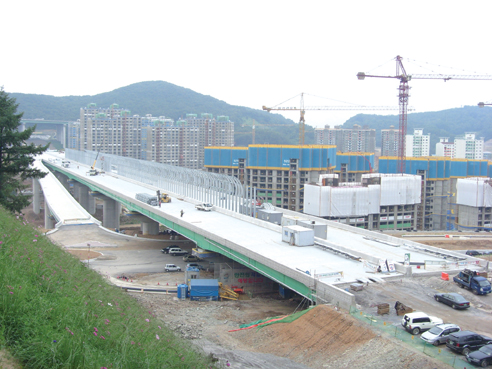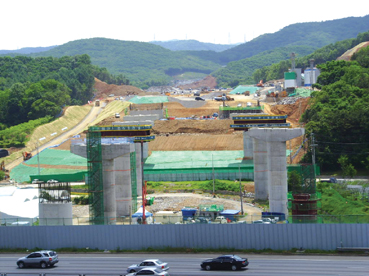Yongin-Seoul Expressway Expected to
Ease Traffic Bottlenecks South of Seoul
A consortium participates in the private investment project
 A sign reads "Now Construction Gets Underway"at the site of a grand, long bridge along national road No. 57 heading toward Anyang just off the Pangyo Intersection on the way from the Hannam Bridge via the Gyeongbu (Seoul-Busan) Expressway. Workers can be seen laboring around the clock to complete the Yongin-Seoul Expressway by the end of next June.
A sign reads "Now Construction Gets Underway"at the site of a grand, long bridge along national road No. 57 heading toward Anyang just off the Pangyo Intersection on the way from the Hannam Bridge via the Gyeongbu (Seoul-Busan) Expressway. Workers can be seen laboring around the clock to complete the Yongin-Seoul Expressway by the end of next June.
It is one of major projects being pushed by the Ministry of Land, Transport and Maritime Affairs and is designed to relieve traffic bottlenecks on the southern outskirts of Seoul. If completed as scheduled, it will cut down the travel time to Gangnam, an affluent district of Seoul, by 30 minutes compared to the existing roads.
Yoon Ki-jong, managing director of Daewoo Engineering & Construction and concurrently head of the Yongin-Seoul Expressway Construction Corps, said, "In 2005, the (then) Ministry of Construction and Transportation
 announced a plan for the improvement of traffic conditions and a project to build the Yongin-Seoul Expressway at a cost of 1.4 trillion won in late October 2005. A consortium of six contractors -- Daewoo E&C, Lotte E&C, Singdongah E&C, POSCO E&C, Sungjee Construction Co. and Wonha Construction Co. -- and financial investors, MKIF and KIFII, are participating in the private investment project."
announced a plan for the improvement of traffic conditions and a project to build the Yongin-Seoul Expressway at a cost of 1.4 trillion won in late October 2005. A consortium of six contractors -- Daewoo E&C, Lotte E&C, Singdongah E&C, POSCO E&C, Sungjee Construction Co. and Wonha Construction Co. -- and financial investors, MKIF and KIFII, are participating in the private investment project."
"Consortium participants are doing their utmost in managing the process, quality, safety and environment in order to make good on a promise with clients. The project involves a 22.9 km-long national expressway with a designated speed limit of 100 km per hour, consisting of 21 bridges, 10 tunnels, an underpass, seven interchanges and three tollgates
![]() It will pass the Heungdeok district in Yongin, the Gwanggyo Techno Valley in Suwon, the Seongbok and Shinbong areas in Yongin and the Pangyo new satellite city in Seongnam,"Yoon said.
It will pass the Heungdeok district in Yongin, the Gwanggyo Techno Valley in Suwon, the Seongbok and Shinbong areas in Yongin and the Pangyo new satellite city in Seongnam,"Yoon said.
 Seven contractors are engaged in the construction of the expressway linking Yeongdeok-dong, Giheung-gu, Yongin City, south of Suwon and Saegok-dong, Gangnam-gu, Seoul, which is divided into six sections.The first section of the projected expressway will run through the Yeongtong District in Suwon and the Heungdeok District in Yongin, establish the Heungdeok Interchange by crossing National Road No. 42, build an underpass to preserve a forested area in the Gwanggyo District and then cross over the Yeongdong Expressway.
Seven contractors are engaged in the construction of the expressway linking Yeongdeok-dong, Giheung-gu, Yongin City, south of Suwon and Saegok-dong, Gangnam-gu, Seoul, which is divided into six sections.The first section of the projected expressway will run through the Yeongtong District in Suwon and the Heungdeok District in Yongin, establish the Heungdeok Interchange by crossing National Road No. 42, build an underpass to preserve a forested area in the Gwanggyo District and then cross over the Yeongdong Expressway.
 The second construction section will pass through the Sanghyeon Intersection, crossing National Road No. 43, the Seongbok Intersection, crossing the Seongbok and Shinbong areas, and the Seongbok Tollgate, a segment in which motorists can appreciate views of one of Mt. Gwanggyo's ridges.
The second construction section will pass through the Sanghyeon Intersection, crossing National Road No. 43, the Seongbok Intersection, crossing the Seongbok and Shinbong areas, and the Seongbok Tollgate, a segment in which motorists can appreciate views of one of Mt. Gwanggyo's ridges.
A massive civil engineering work will build the Gogi Junction, part of the third construction section.
The fourth construction section will run through the Pangyo new satellite city with such major facilities as the Seopangyo Intersection and a long bridge whose upper deck has tunnel-type soundproofing walls designed to minimize the inconvenience to residents.
The fifth construction section will crisscross the Seoul Outer Loop Expressway, the Gyeongbu Expressway and run through the Geumto Tollgate. It will have views of Mt. Cheonggye, a major trekking course for residents of the Seoul metropolitan area.
The sixth construction section has a tunnel and a bridge under construction. The section, linking Bundang and Seoul,
 will cross the Bundang-Naegok Expressway. Work on the Heonneung Intersection, to be connected with the Gangnam area of Seoul, is underway at the end of the Yongin-Seoul Expressway.
will cross the Bundang-Naegok Expressway. Work on the Heonneung Intersection, to be connected with the Gangnam area of Seoul, is underway at the end of the Yongin-Seoul Expressway.
The project is designed with underpasses, roads and tunnels aimed at preserving forested areas as well as eco-corridors for protecting the ecology of animals and other facilities aimed at minimizing the impact on the surrounding environment.
The projected expressway is fitted with intelligent transportation systems (ITS) encompassing a broad range of wireless and wired communications-based information and electronic technologies in the interests of motorists. Safety-related facilities will be set up to ensure the safety of cars running at speeds of up to 100 km per hour.
Once completed, the expressway is expected to contribute greatly to easing traffic bottlenecks in the southern outskirts of Seoul where the existing Bundang-Suseo and Bundang-Naegok expressways have already reached the saturation point. Specifically,
 it will reduce travel time for motorists traveling from Suwon to the Gangnam area by 30 minutes.
it will reduce travel time for motorists traveling from Suwon to the Gangnam area by 30 minutes.
From the beginning, it was not easy for the project to break ground. Departing from the past development method in which road infrastructure was built up before the construction of new satellite cities, the project faced difficulties since it proceeded after new satellite cities were already built or planned. The project suffered a setback as it was struck with conflicts of interests from residents who were affected by the construction of the expressway, which passes through major residential areas. The project managed to proceed after a compromise with residents as contractors have focused on maximizing the benefits residents gain through the development plans and minimize damages inflicted on them, preserve forested areas and minimize environmental damage.
Contractors are putting more energy into completing the eco-friendly Yongin-Seoul Expressway on schedule in order to make the project an example of a strong, convenient road built based on dialogue and compromise as well as a harmonious combination of human beings, nature and technology. nw
The Hasanun Bridge cutting through the Pangyo residential zone
Yoon Ki-jong, managing director of Daewoo Engineering & Construction and concurrently head of the Yongin-Seoul Expressway Construction Corps
Construction partners of the Yongin-Seoul Expressway Project Consortium
(clockwise) The Godeung Bridge overpassing the Budang-Naegok Expressway, the Deumto No. 3 Bridge overpassing the Gyeongbu Expressway, Seongbok Tollgate construction site and the Shinbong Bridge bordering the Shinbdong District.
3Fl, 292-47, Shindang 6-dong, Chung-gu, Seoul, Korea 100-456
Tel : 82-2-2235-6114 / Fax : 82-2-2235-0799